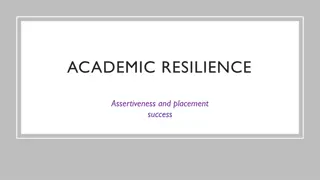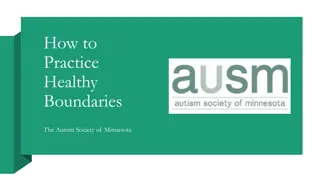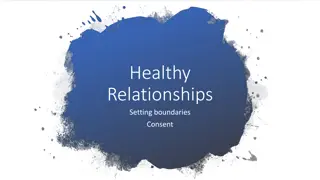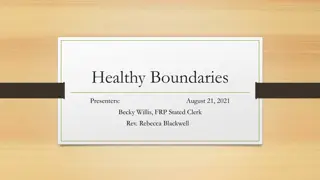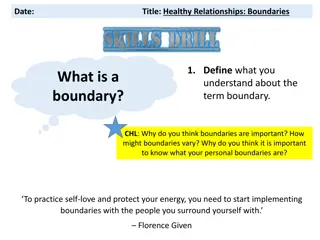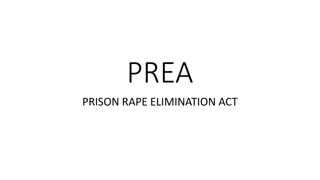Boundaries
Explore the importance of boundaries in professional relationships, including boundary crossings and violations, reasons for violations, and guidelines to prevent them. Learn how boundaries define the helping pathway for clients and professionals, and discover key factors contributing to boundary violations.
Download Presentation

Please find below an Image/Link to download the presentation.
The content on the website is provided AS IS for your information and personal use only. It may not be sold, licensed, or shared on other websites without obtaining consent from the author.If you encounter any issues during the download, it is possible that the publisher has removed the file from their server.
You are allowed to download the files provided on this website for personal or commercial use, subject to the condition that they are used lawfully. All files are the property of their respective owners.
The content on the website is provided AS IS for your information and personal use only. It may not be sold, licensed, or shared on other websites without obtaining consent from the author.
E N D
Presentation Transcript
Boundaries Psychology Team
Quote Boundaries are a Warm, Firm Hug by Dr. Charles Preston
What are Boundaries? According to Everett and Gallop (2001) Boundaries define the helping pathway for both clients and professionals and as such are integral to professional effectiveness (p. 229). The National Council of State Boards of Nursing defines boundary crossings as a decision to deviate from an established boundary for a therapeutic purpose. These are brief excursions across boundaries with a return to the established limits of a professional relationship (Peternelj-Taylor, 2003).
Boundary Crossings and Violations Some examples of boundary crossings include: Small gifts (giving and accepting) Excessive self-disclosure of personal information Extending time beyond what was initially agreed Saying yes rather than no Making special allowances for patient Nonemergency meetings outside the office Examples of boundary violations include: Avoidable dual or multiple relationships (friend vs. professional) Sexual relationships
Why do Boundary Violations Occur? Sarkar (2004) feels that a key factor in why boundary violations occur is that treating professionals have both personal and professional identities. Pilette et. al., (1995). Inability to identify the difference between the professional relationship and a social relationship. Attempting to have personal needs met through the staff-client relationship. Someone who has trouble asserting boundaries will have trouble re- establishing boundaries later. Once the line is crossed, it s hard to pull back.
Guidelines to Avoid Boundary Violations Pope and Keith-Spiegel (2008) offer the following guidelines to consider when determining if boundary crossing is likely to be helpful vs. harmful or supportive vs. disruptive Imagine what might be the "best possible outcome" and the "worst possible outcome" from crossing this boundary vs. not crossing this boundary. Does this crossing or not crossing seem to involve risk or negative consequence? Is there risk of serious harm in the short-term or long-term?
Guidelines to Avoid Boundary Violations Be familiar with your ethics code. Identify at least one colleague you can trust for honest feedback Consult prior to making a decision if you re unsure. Pay attention to any uneasy feelings, doubts, or confusions Listen to your instincts! These intuitive sources of information are often invaluable to ethical decision-making
Consequences to Providers & Staff of Boundary Violations Fry (2008) conducted research with therapist and found: Less personal time with family and friends Less job satisfaction Co-worker frustrations Burnout Compassion fatigue/burnout Fry also lists extreme consequences of boundary violations: Loss of job Loss of license Loss of professional identity
How Do We Establish Healthy Professional Boundaries? Learn to say no. Many of us are people-pleasers and often put ourselves at a disadvantage by trying to accommodate others. Identify the actions and behaviors that you find unacceptable. Let others know when they've crossed the line, acted inappropriately/unprofessionally, or disrespected you in any way. Trust and believe in yourself. You are the highest authority on you. You know what you need, want, and value. Don't let anyone else make decisions for you. Healthy boundaries make it possible for you to respect your strengths, abilities and individuality as well as those of others.
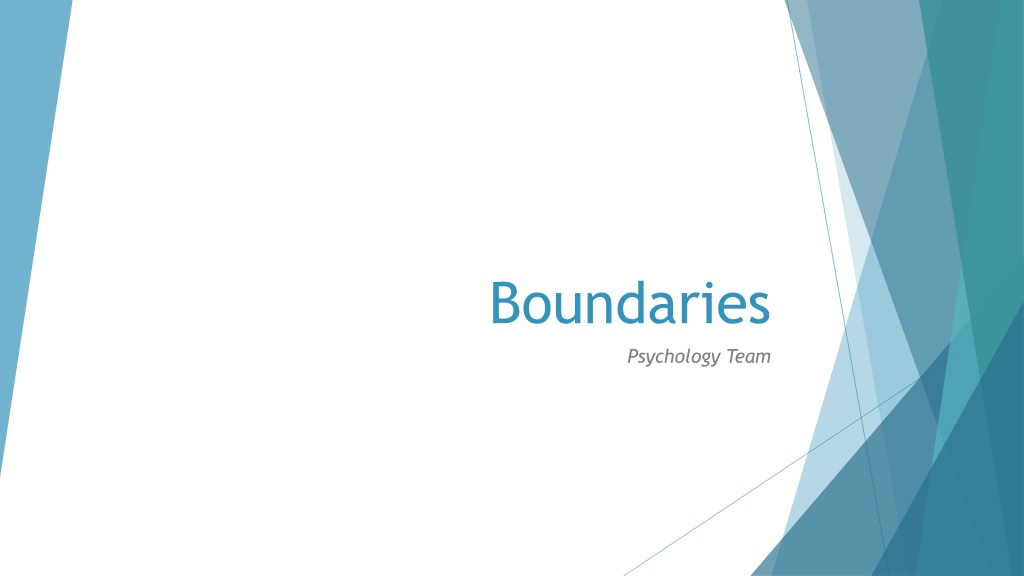
 undefined
undefined






